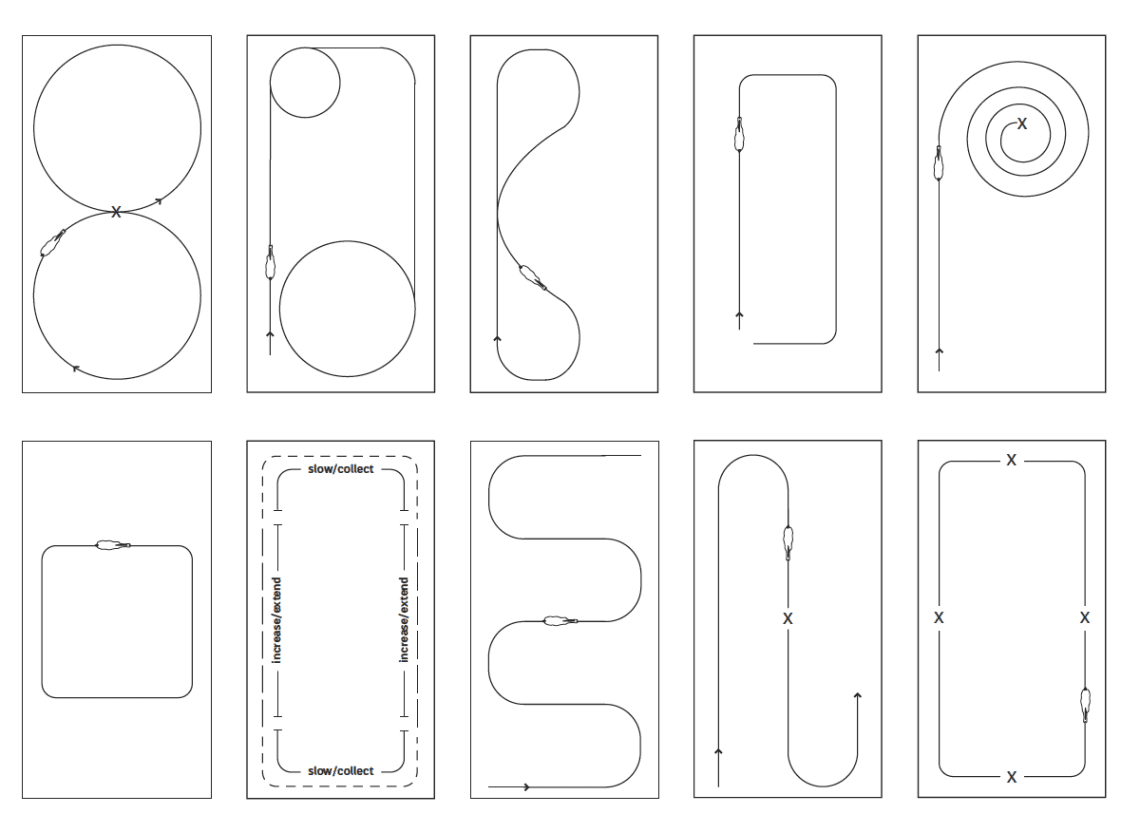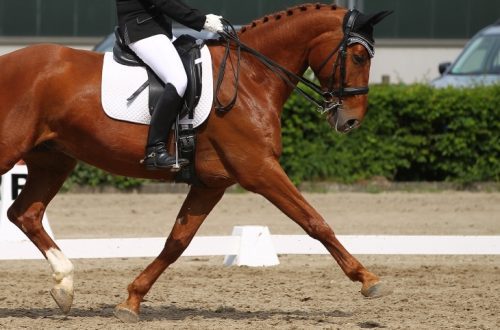
Bring variety to the arena work! (10 exercises)
Bring variety to the arena work! (10 exercises)
You work in the arena independently, stretched the horse on a pleasant trot, moving along the walls. Now they have changed direction. And so you spin, spin, and you begin to become unbearably bored. The horse also starts to get bored. And if you start to get distracted from work and wander in your thoughts somewhere outside the arena, then your horse does the same.
Get rid of the routine. Use the exercises below to add variety to your workouts. They are suitable for warming up, and in order to set up the horse before a trip to the forest or field. When you break the monotony, you also improve your horse’s responsiveness, suppleness and muscle tone, and polish your riding skills.
The following 10 exercises offer the possibility to increase or decrease the difficulty, so they can be adapted to suit the abilities of both the rider and the horse. To make the work even more interesting, combine exercises or create your own!
To make your work as efficient as possible:
- ВAlways do each exercise in both directions.
- Use your inside leg at the girth to bend your horse through turns and circles, and use your inside rein to point his nose in the direction of travel. Use the outside leg just behind the girth and use the outside rein on the horse’s neck to stabilize the bend. Use your foot on or just behind the girth and the rein on the same side of the neck to ask for a lateral movement.
- Work to keep your controls as inconspicuous and subtle as possible.
- Look ahead where you are riding (not down on the horse and not on the ground).
1. Basic “eight”
What to do? Ride the figure eight path, using the straight line in the center (X) to change the horse’s curve before moving in the new direction.
Benefits for the rider: This exercise improves your ability to bend the horse, guide it exactly on the right path and keep it exactly on two reins (“straight” circle, which means bending it according to the arc of the circle).
Benefits for the horse: the exercise encourages her to bend equally in both directions and to pay close attention to your messages.
Tips: Focus on keeping your circles round and equal in size. Pay attention to the amount of rein and leg needed for a proper bend. Place a cone in the center of the arena for a visual cue.
Modification: easy level – perform at walk and trot. Make it more difficult – change speed, change gaits to X or canter and perform a simple change of foot or change of foot in the air to X.
2. Big circle – small circle
What to do? We ride along the wall of the arena, in one corner we make a small circle, then in the diagonally opposite corner we make a large circle.
Benefits for the rider: improves the ability to bend the horse depending on the trajectory of the circle.
Benefits for the horse: improves flexibility due to driving in a small circle; the horse learns to maintain balance while riding circles of various sizes.
Tips: select in arena “landmarks” to help you make circles of the right size in the right places.
Modification: Change the angles at which you make small and large circles. Make it harder by changing the speed, or doing a big circle at a canter and a small circle at a trot.
3. Loops in the shape of the letter “B”
What to do? We go down the long wall of the arena, turn in the corner and make a turn to the left back, again we return to the wall. Then again we reach the corner and make a check-in to the right back.
Benefits for the rider: This exercise improves the accuracy of the horse’s straightening and bending skills.
Benefits for the horse: The exercise encourages her to “listen” to the rider rather than assuming she has to go a full circle. If you ride in two tracks (see “modification” below), this will improve its lateral flexibility.
Tips: Try to make each run back the same size and shape.
Modification: easy level – walk and trot. Let’s make it more difficult – we go at a gallop and change the leg in the center of a straight segment along the wall of the arena. At any gait, using your outside leg and rein, return to the wall in two tracks, moving forward and sideways.
4. Serpentine
What to do? Make a series of connected S-shaped serpentines back and forth across the entire width of your arena.
Benefits for the rider: the exercise forces you to focus on each new turn, shifting the horse to the opposite rein and leg with each change of direction; it sharpens your horse bending skills.
Benefits for the horse: the horse becomes lighter and more agile as it bends, changes direction, and listens to your signals.
Tips: Try to make loops of the same size and shape.
Modification: easy level – we make only two or three loops. We complicate – we make four or five narrower loops. This exercise is very difficult to do at canter – you will need to constantly change your foot on each straight section or do loops at a counter canter.
5. Rectangle on the second track
What to do? Instead of driving along the walls, we drive at a distance of 2,40-3,00 meters from them.
Benefits for the rider: you learn to hold the horse in two reins and move it in a straight line – without a wall to support you or the horse.
Benefits for the horse: the exercise teaches her to rely on your signals, and not on the wall of the arena.
Tips: Start with a walk, then move to a trot and a canter.
Modification: Make it harder by changing the speed while moving in a straight line.
6. Spiral
What to do? Gradually narrow the large circle until you reach the smallest possible circle, then “unwind” as the circle gets larger.
Benefits for the rider: exercise improves the spatial sense of the circle; improves your lateral controls.
Benefits for the horse: the exercise has a positive effect on her ability to bend and collect, and also makes her more responsive to your outside leg and rein (inward spiral) and inside leg and rein (outward spiral); keeps the horse flexible and supple, engages the hindquarters.
Council: Focus on maintaining a constant speed.
Modification: This exercise is very difficult to perform in any gait. Start with a walk, then move on to a trot and a canter.
7. Long serpentine
What to do? Run the serpentine not in width, but in the length of the arena. On the letter X “do something” – stop; perform some kind of movement (moving to the side, pirouette, reining down, etc.); Or change your leg. Then continue down the center line, turning on the wall in the opposite direction.
Benefits for the rider: The exercise forces you to work when you need to keep the horse on the center line before and after the X maneuver.
Benefits for the horse: exercise improves bending, straight movement and transition skills.
Council: for visual cue add a marker in the center of the arena.
Modification: simple level – on the letter X we make a stop or change the gait. We complicate – we change the speed and / or perform a leg change in the center of the arena.
8. Building a cadence
What to do? Increase your speed when you ride along the long walls of the arena, shorten the horse on short ones.
Benefits for the rider: you learn to gradually increase and decrease speed, develop the skill to collect a horse.
Benefits for the horse: the exercise teaches her to increase / decrease speed calmly, without excitement; helps develop the muscles she needs to maintain collection.
Council: Calm your horse right before slowing down in corners.
Modification: a simple level – we go at a walk or trot. We complicate – we work at a canter or we pass the long sides at a canter, and the short ones at a trot.
9. Setting up transitions
What to do? We go along the walls of the arena. In the middle of each wall we make a transition. For example, let’s start with a step; opposite the letter X, we move to a trot; on the next wall against X we return to the step, etc. Alternate any transitions (walk, trot, canter).
Benefits for the rider: The exercise helps you smooth out your up and down transitions and also improves your overall control.
Benefits for the horse: the exercise keeps her attention; improves collection; develops the back muscles.
Tips: always plan ahead for your transition point, prepare a step or two in advance to make the transition in a well-defined place; add visual markers if needed.
Modification: make it harder by working at faster paces or by asking for a full stop at some points opposite X.
10. Rounded square
What to do? Imagine a square with rounded corners. Ride straight, bend your horse and turn 90 degrees, continue straight ahead on the next side of the square.
Benefits for the rider: this exercise is more difficult than a simple circle ride. It forces you to think and follow the ride.
Benefits for the horse: The exercise helps her understand the difference between bending and moving in a straight line.
Council: Add markers in each corner for a visual cue.
Modification: easy level – walk or trot and make a wider turn at each corner. Making it harder is working at a canter and/or making turns a little tighter.
Debbie Moores (source); translation by Valeria Smirnova.





